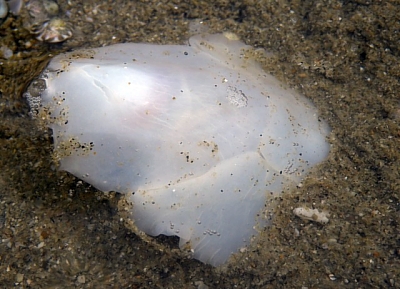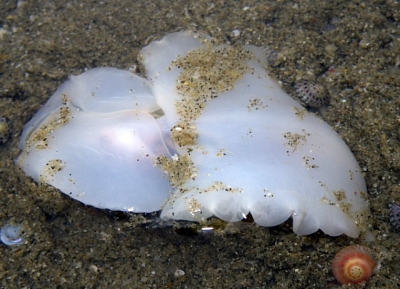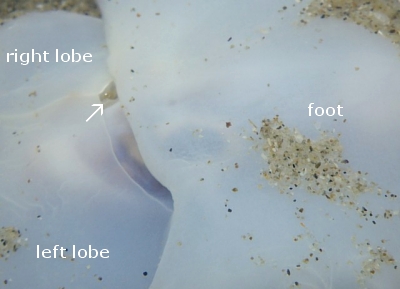Re: Philine orientalis? from Singapore
March 17, 2009
From: Loh Kok Sheng


Concerning message #15459:
Dear Dr Bill,
Here are photos of Philine from Singapore. Thought it will be a first record for Singapore. Am not sure if you can get the identification from the photos.
Locality: Tanah Merah , Singapore, Singapore Straits, 7 February 2009, Intertidal, Sand bar. Length: 60 mm. Photographer: Loh Kok Sheng.
Thanks!
Loh Kok Sheng
kokshengz@gmail.com
Loh, K.S., 2009 (Mar 17) Re: Philine orientalis? from Singapore. [Message in] Sea Slug Forum. Australian Museum, Sydney. Available from http://www.seaslugforum.net/find/22341
Dear Kok Sheng,
It is hard to be sure of its identification without looking at least at its internal shell and gizzard plates, but as I said in Dong Bum Koh's message, this muscular, wedge-shaped body form is only found in a few species, including P. orientalis.
For those unfamiliar with species of Philine, your upper photo shows an animal burrowing into the sandy bottom. The wedge-shaped and muscular body are modified for this burrowing life. The front end of the body, including most of the head shield and flanking parapodia are almost totally buried, while the 'posterior shield' with the bright white internal shell are still visible.
The middle photo shows the ventral side of an animal which has been lying on its back and has just buried its head [right end of photo] in the sand and I assume is about to flip over before completely burying itself. The lower photo is a close-up of part of the ventral photo and I have labelled a few of the body parts. As in many cephalaspideans, the foot does not extend to the posterior end of the body, usually the most posterior part of the body is the shell. In species, such as Philine, in which the shell is internal we call the part of the body that encloses the shell and the remnant mantle cavity the posterior shield. In the lower photo we can see how the posterior shield folds under to form to lobes which enclose the mantle cavity and gill. I have arrowed the opening through which water is drawn inot the mantle cavity.
Best wishes,
Bill Rudman
Related messages
-
Shell & gizzard plates of Philine orientalis
From: Dong Bum Koh, May 2, 2006 -
Philine orientalis from South Korea
From: Dong Bum Koh, December 16, 2005 -
Radula of Hong Kong Philine orientalis
From: Bill Rudman, August 10, 1998 -
Philine orientalis? from Hong Kong
From: Bill Rudman, August 5, 1998
